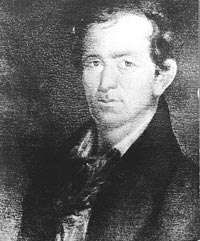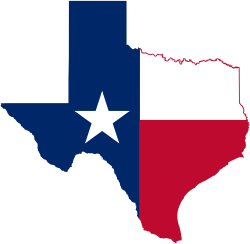Deaf Smith
Erastus "Deaf" Smith (April 19, 1787 – November 30, 1837) was an American frontiersman noted for his part in the Texas Revolution and the Army of the Republic of Texas. He fought in the Grass Fight and the Battle of San Jacinto. After the war, Deaf Smith led a company of Texas Rangers.
Deaf Smith | |
|---|---|
 Deaf Smith | |
| Born | Erastus Smith April 19, 1787 |
| Died | November 30, 1837 (aged 50) |
| Occupation | American frontiersman, Texas Revolution hero, Republic of Texas soldier, Texas Rangers |
| Spouse(s) | Guadalupe Ruiz de Durán; 3 children & 4 stepchildren |
Part of a series on the |
||||||||||||||||||
|---|---|---|---|---|---|---|---|---|---|---|---|---|---|---|---|---|---|---|
| History of Texas | ||||||||||||||||||
 | ||||||||||||||||||
| Timeline | ||||||||||||||||||
|
||||||||||||||||||
|
| ||||||||||||||||||
Early life
Smith was born in Dutchess County, New York to Chilab and Mary Smith on April 19, 1787. In 1798, his family moved to Port Gibson, Mississippi, near Natchez. A childhood disease resulted in him losing his hearing.[1]
Mexican Texas
He first came to Mexican held Texas in 1817 but did not remain long; he returned to Texas in 1821 and settled in San Antonio de Bexar.[2]
Family
In 1822, Smith married a Tejana, Guadalupe Ruiz de Durán (b. 12 December 1797), the daughter of Salvador Ruiz de Castaneda and María Ygnacia Robleau. Guadalupe was the widow of Jose María Vicente Durán (m. 1812), by whom she had three children: Refugia, Josefa, and Lucinda. The Smiths had four children: Susan Concepcion (b. August 15, 1823 – d. 22 Jan 1849), Gertrudes (b. 1825; m. Macario Tarin), Travis (b. 1827 – d. 1833), and Simona (b. October 28, 1829, Mission Espada – died November 11, 1890). Susan C. Smith married Nathaniel Fisk (b. September 4, 1815, Scranton, Vermont – died April 5, 1876) in 1839. After her death, Fisk married her sister, Simona, on August 1, 1849.
His family moved to Columbia, Texas in 1835 after the siege of Bexar had ended.[3]
Surveying
In 1825 Smith joined James Kerr and a handful of other men in surveying the DeWitt Colony.[3][4]
Deaf Smith moved freely between Anglo and Hispanic Tejano societies, and spent much time learning Mexican customs and Spanish.[2] Because of his knowledge of both Anglo and Hispanic cultures and the terrain of Texas, he served as a guide, scout, and spy.
Texas Revolution
Texan Army
Even as many Texas settlers formed an army and marched on San Antonio de Bexar, Smith originally intended to remain neutral. He changed his mind after the Texian Army, led by Stephen F. Austin, initiated a siege of Bexar. As the siege began, Smith and his son-in-law Hendrick Arnold were absent from town, on a hunting trip. The Mexican army increased security in the town, and refused to allow Smith and Arnold to return to their homes within the city. An indignant Smith immediately joined the Texian Army.[1][2] He wrote to Austin: "I told you yesterday that I would not take sides in this war but, Sir, I now tender you my services as the Mexicans acted rascally with me".[5]
His intelligence gathering was important at the Battle of Concepcion. In October 1835, he discovered the mule train that brought on the Grass Fight, and in December 1835, he guided troops into San Antonio in the Siege and Battle of Bexar, where he was wounded atop the Veramendi House at the same time that Ben Milam was killed. After the evacuation of centralista troops from San Antonio in the latter engagement, he moved his family to Columbia. At the Alamo, he served as a courier to William Barrett Travis and carried Travis's letter from the Alamo on February 15, 1836.[1] He met General Sam Houston at Gonzalez after the signing of the Texan Declaration of Independence at Washington-on-the-Brazos, Texas. Dispatched back to Bexar, Houston relied on Smith to determine the fate of the Alamo garrison. He met and escorted Susanna Dickinson and party to report to General Houston in Gonzales regarding the fate of the Alamo defenders.
Texas cavalry company
In Gonzales, Smith was assigned to Captain Karnes' Cavalry Company of the 1st Regiment of Volunteers and promoted to captain in command of new recruits. Smith operated continuously on the way to, at, and after the Battle of San Jacinto with small groups of volunteers from the cavalry unit and sometimes other units, successfully generating intelligence and special missions almost continuously.[6] At Harrisburg, he captured a Mexican courier with dispatches revealing the strength and position of Antonio López de Santa Anna's army. On April 21 prior to the Battle of San Jacinto, his men and he destroyed Vince's Bridge, the means of any retreat or reinforcements of both armies. He joined his unit to participate in the main battle. He was the courier who took the captured Santa Anna's orders to General Filisola's army to retreat from Texas. He captured General Cos, who had escaped from the main battle.
Laredo, Texas
After the Battle of San Jacinto, Deaf Smith returned to Columbia and later moved to Richmond in Fort Bend County. Shortly before his death, Smith raised a company of 20 Texas Rangers, who fought on March 17, 1837, near what is the present-day location of the Laredo International Airport in Laredo, against a superior Mexican force. Two of Smith's men were wounded, and 10 Mexicans were killed and 10 others injured. Smith also captured 40 horses. This incident occurred nearly a year after General Lopez de Santa Anna had surrendered at San Jacinto to General Sam Houston. Smith, at the time, offered no further resistance against the Mexicans, and he guided the Texans back to San Antonio.
After the War
The Republic of Texas legislature in November 1836 had granted Smith "any house and lot in the city of Bexar, which may be confiscated for public use". His widow chose the old Granado homeplace at the southeast corner of Main Plaza and Commerce Street in San Antonio. Smith was also granted land for his service to the Texas Republic.[3]
Death
Smith died in Richmond, Texas, at age of 50, at the home of Randall Jones. The Episcopal churchyard has a modest marker, "Deaf Smith, the Texas Spy, Died Nov. 30, 1837", but his exact burial site is unknown.[7] His widow returned to San Antonio, died there on May 1, 1849, and is interred at the Catholic Cemetery.
Posthumous legacy
Deaf Smith County, Texas, is named in his honor,[8] which unlike his nickname, which was pronounced "Deef", is pronounced by most residents as /ˈdɛf/ DEF. Likewise, a brand of peanut butter known as Deaf Smith was manufactured by the Arrowhead Mills company, which was founded in 1960 by Frank Ford, then from Hereford, the seat of Deaf Smith County.
Smith is also honored for his work in South Texas with a historical marker at the entrance to Lake Casa Blanca International Park in Laredo.
Many school districts in Texas name schools after heroes of the Texas Revolution. Several schools across the state are named for Deaf Smith, including Lamar CISD's Deaf Smith Elementary in Richmond, Texas.
In popular culture
- 1915, Martyrs of the Alamo, Smith was played by Sam De Grasse (as "Silent Smith")
- 1939, Man of Conquest, Smith was played by Max Terhune.
- 1956, The First Texan, Smith was played by Chubby Johnson.
- 1958, in "Deaf Smith" episode of The Adventures of Jim Bowie, Deaf Smith was played by Vic Perrin.
- 1960, The Alamo, Smith was played by Frankie Avalon (as "Smitty").
- 1972, Los Amigos (Smith and Johnny Ears) is based on Smith; Anthony Quinn played the Deaf Smith character.
- 1986, TV movie Houston: The Legend of Texas, Smith was played by Ivy Pryce.
- 1998, TNT's TV Movie Two for Texas, Smith was played by Richard Andrew Jones.
- 2004, Alamo, Smith was played by Michael Crabtree.
- 2015, Texas Rising, Smith was played by Jeffrey Dean Morgan.
References
- CUTRER, THOMAS W. (2010-06-15). "SMITH, ERASTUS [DEAF]". tshaonline.org. Retrieved 2020-05-27.
- "Erastus Smith". www.gallaudet.edu. Retrieved 2020-05-27.
- "SMITH, ERASTUS (DEAF)". San Jacinto Museum of History. Retrieved May 27, 2020.
- ROELL, CRAIG H. (2010-06-12). "DEWITT'S COLONY". tshaonline.org. Retrieved 2020-05-27.
- Barr (1990), p. 17.
- Gannon, Jack. 1981. Deaf Heritage–A Narrative History of Deaf America, Silver Spring, MD: National Association of the Deaf, pp. 4-5 (PDF Archived March 28, 2012, at the Wayback Machine)(PDF Archived March 28, 2012, at the Wayback Machine)
- "Unknown Grave of a Texas Spy". The Texian Gazette (Fort Bend Archeological Society) (4th Quarter 2017): 4–6. Retrieved November 28, 2017.
- Gannett, Henry (1905). The Origin of Certain Place Names in the United States. Govt. Print. Off. pp. 102.
References
- Barr, Alwyn (1990). Texans in Revolt: the Battle for San Antonio, 1835. Austin, TX: University of Texas Press. ISBN 0-292-77042-1.
- "Battle of San Jacinto" A Texas Historical Commission historical marker.
- ” Daughters of the Republic of Texas, Muster Rolls of the Texas Revolution (Austin, 1986).
- ” Joseph Milton Nance, Attack and Counterattack: The Texas-Mexican Frontier, 1842 (University of Texas Press, 1964).
- ” The Writings of Sam Houston, 1813-1863 (University of Texas Press, 1938)
- Erastus "Deaf" Smith historical marker, Lake Casa Blanca International State Park, Laredo, Texas, dedicated 1936
External links
| Wikimedia Commons has media related to Deaf Smith. |